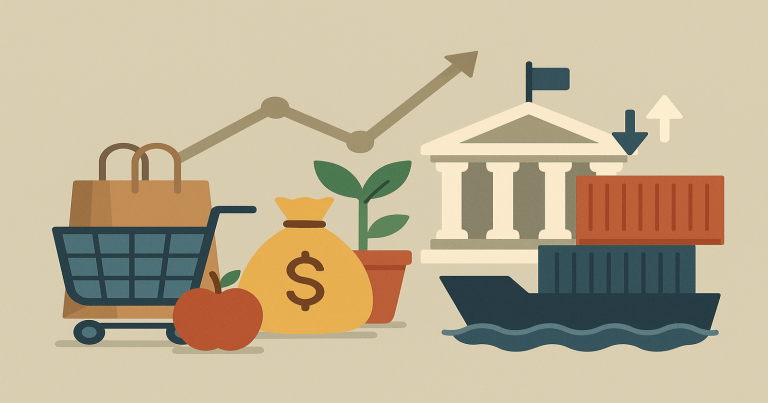India and other countries use different ways to calculate their national income. One of the most common methods is the expenditure method. This method adds all the spending made by people, businesses, and the government on final goods and services in a year. The total of this spending shows the country’s Gross Domestic Product (GDP). So, the expenditure method helps to understand how much people and firms are spending, which in turn reflects how well the economy is doing.
In economics, this method is important because it gives a clear picture of where the money is going. It shows which sectors of the economy are growing. For example, if people are spending more on houses or education, it means those sectors are doing well. This helps the government plan better policies.
The expenditure method of calculating GDP includes several parts – household spending (also called consumption), investments made by companies, government spending, and the difference between exports and imports. If we add all these, we get the GDP using this method.
What is the Expenditure Method in Economics?
The expenditure method in economics is one of the three main methods to calculate the GDP of a country. The other two methods are the income method and the output (or production) method. The expenditure method focuses on the total amount of money spent in the economy during a particular time, usually a year.
This method assumes that whatever is produced in the country is either consumed, invested, bought by the government, or exported. It does not count any unpaid work or work done at home. It also avoids counting intermediate goods to stop double counting.
Economists prefer this method when they want to understand demand in the economy. For example, if consumer spending is high, it means people have more money and confidence. On the other hand, if government spending is the main reason for GDP growth, it shows a different trend.
Why is it used?
Governments use the expenditure method of national income to check the economy’s health. It is helpful in planning budgets, setting interest rates, and deciding tax policies. It also helps in comparing growth between countries.
Components of Expenditure Method
To calculate GDP using the expenditure method, we must add the following parts:
1. Private Final Consumption Expenditure (C)
This is the money people spend on daily goods and services like food, clothes, transport, and education. It is the biggest part of the GDP in most countries.
2. Gross Domestic Capital Formation or Investment (I)
This includes money spent on machines, buildings, and other capital goods. It also includes inventory changes.
3. Government Final Consumption Expenditure (G)
This includes all spending by the government on services like health, defence, and education. It excludes transfer payments like pensions.
4. Net Exports (X – M)
This is the value of exports minus the value of imports. If exports are more, the value is positive. If there are more imports, it is negative.
The formula for GDP Using Expenditure Method
| GDP=C+I+G+(X−M) |
Explanation of Each Term:
- C = Spending by households on goods and services
- I = Firms spend money on equipment and infrastructure.
- G = Spending by government on public services
- X = Income from goods sent abroad
- M = Money spent on goods bought from other countries
The expenditure method formula helps to find the total money flowing in the economy through demand.
Real-Life Example of Expenditure Method
Let’s understand this method better by using an example from India’s economy.
Suppose in a year:
- Households spend ₹1,000 crore on consumption
- Firms invest ₹500 crore in new buildings and machines.
- The government spends ₹400 crore on services.
- Exports are ₹300 crore
- Imports are ₹200 crore
Using the formula:
GDP=C+I+G+(X−M)=₹1000+₹500+₹400+(₹300−₹200)
=₹1000+₹500+₹400+₹100=₹2000crore
So, India’s GDP for that year using the expenditure method of GDP calculation is ₹2000 crore.
Uses and Importance of Expenditure Method
The expenditure method of national income has many uses. It helps in policymaking, budget planning, and even business decisions.
1. Economic Planning
This technique is applied by governments in preparing the budget. When consumer spending decreases, the government spends more to stimulate the economy.
2. Investment Analysis
Investors make decisions based on this information whether or not to invest in stocks, bonds, or real estate. An increase in investment indicates firms anticipate positive returns.
3. Inflation Control
If GDP grows too fast due to spending, it can lead to inflation. Policymakers use the data to increase interest rates and control prices.
4. International Comparison
Countries compare their GDP using this method. This helps in knowing who is doing well in global trade and economy.
The method is widely used in India’s GDP estimates, and it is a key part of reports by the National Statistical Office (NSO).
Limitations of Expenditure Method
While the expenditure method in economics is helpful, it also has some drawbacks.Here, we will explain the main limitations of the expenditure method, such as ignoring unpaid work, missing informal sector data, not showing income gaps:
1. Excludes Non-Market Activities
It does not include work done at home, such as cooking or caring for children. This may reduce the total value shown.
2. Hard to Track Some Spending
Illegal or unrecorded spending, like in the black market, is not counted. This may hide real demand.
3. Focuses Only on Demand
It does not show how income is distributed. Two countries may have the same GDP, but one may have very rich people while others are poor.
4. Imports May Reduce GDP
If a country imports a lot, its GDP becomes lower in this method. But those imports may be essential for development.
Despite these problems, economists still use this method because it is easier to apply and gives quick results.
Precautions Taken While Applying the Expenditure Method
Applying the expenditure method requires certain precautions to ensure accuracy, avoid double-counting, and correctly interpret the data. These precautions help ensure the expenditure method provides a realistic and reliable estimate of a nation’s GDP and economic health.
Avoiding Double Counting: Only expenditures on final goods and services should be counted, as intermediate goods (like raw materials) are already included in the final goods’ prices.
Consistent Period: The calculation should cover a specific, consistent time frame (e.g., a year) to ensure that the GDP accurately reflects economic activity within that period.
Adjusting for Imports and Exports: Care must be taken to properly include exports, which add to the GDP, and exclude imports, which do not represent domestic production.
Price Level Adjustments: Changes in price levels (inflation or deflation) should be considered to avoid overestimating or underestimating GDP. Real GDP (adjusted for inflation) gives a more accurate picture than nominal GDP.
Accurate Government Data: Accurate data from government agencies on expenditures and investments is crucial for reliable GDP estimation. Incomplete data can lead to inaccurate calculations.
Expenditure Method in India’s GDP Estimation
In India, the Central Statistics Office (CSO) uses the expenditure method along with other methods to estimate GDP. India collects data from households, firms, trade offices, and the government to prepare GDP reports every quarter and annually.
For example, when the Union Budget is presented, the finance minister talks about government spending. That number goes into the ‘G’ part of the formula. Similarly, export and import data are collected from customs offices to fill the ‘X – M’ part.
India’s large consumption sector makes the ‘C’ part of the formula the biggest. This shows that the Indian economy depends heavily on people’s daily spending.
Over the years, India’s data quality has improved. Many reforms like GST, PAN linkage, and digital payments help track real-time spending, which makes the expenditure method in national income even more accurate.
Expenditure Method FAQs
1. What is the expenditure method of GDP calculation?
The expenditure method of GDP calculation adds all the money spent on final goods and services in a country in one year. It includes consumption, investments, government spending, and net exports.
2. What is the formula for the expenditure method?
The expenditure method formula is:
GDP=C+I+G+(X−M)
Here, C = consumption, I = investment, G = government spending, X = exports, M = imports.
3. Why is the expenditure method used in national income accounting?
Governments and economists use the expenditure method in national income to measure total demand and spending in the economy. It helps create better financial policies and checks economic health.
4. What are the components of the expenditure method?
The main components of the expenditure method are:
- Private final consumption (C)
- Investment by businesses (I)
- Government expenditure (G)
- Net exports (X – M)
Each part shows how different sectors contribute to GDP.
5. How is the expenditure method different from the income method?
The expenditure method adds all spending. The income method adds all income earned. Both give the same GDP result but use different data. Expenditure shows demand; income shows earnings.
6. What is included in the investment in expenditure method?
In the expenditure method, investment includes spending on machines, buildings, tools, and changes in inventory. It shows business confidence and future growth plans.
7. Does the expenditure method include imports?
Yes, the method includes imports but as a negative value. Since imported goods are not made in the country, we subtract them from total spending using the (X – M) part of the formula.


